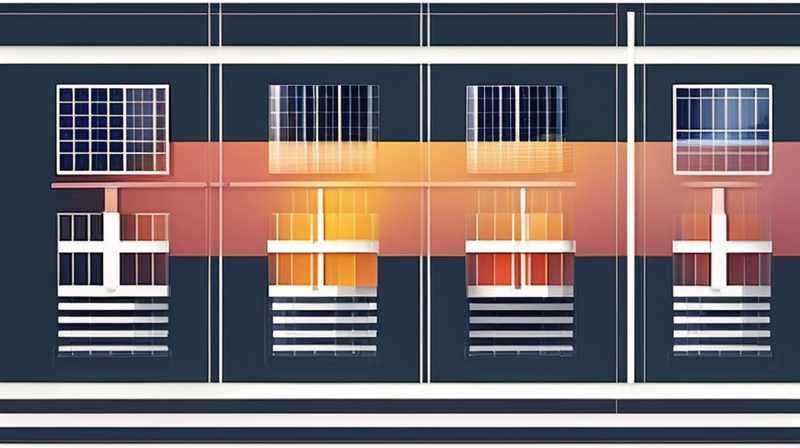
1. Definition of solar panel leakage, 2. Causes of solar panel leakage, 3. Symptoms of solar panel leakage, 4. Solutions and prevention strategies.
Solar panel leakage generally refers to issues where water infiltration occurs within the solar panel structure, leading to damage. It can stem from manufacturing defects, improper installation, or environmental factors. Among these, manufacturing defects can involve subpar materials or inadequate sealing that fails to prevent moisture ingress. In addition, improper installation might encompass poor alignment or sealing, while environmental challenges include exposure to extreme weather conditions that could compromise the integrity of the panels over time. Each of these causes needs thorough examination to ensure effective long-term solutions and maintenance practices.
1. UNDERSTANDING SOLAR PANEL LEAKAGE
The phenomenon of solar panel leakage is a critical concern for homeowners and businesses alike. Understanding the underlying mechanics and structures of solar panels reveals how they are intended to function efficiently. Every solar panel is composed of multiple layers designed to protect sensitive components. These layers usually include tempered glass, an encapsulant, solar cells, a back sheet, and a frame. Any compromise in this configuration can lead to potential water ingress.
Consequently, the integrity of the solar array is essential for both performance and longevity. When water penetrates these layers, it can lead to corrosion of electrical components, reduced efficiency, and even total failure of the system. The need for vigilance in monitoring for signs of leakage cannot be overstated, as it can mitigate significant long-term costs associated with repairs or replacements.
2. IDENTIFYING CAUSES OF LEAKAGE
Several factors contribute to the occurrence of solar panel leaks. Manufacturing defects commonly surface as one source of potential problems. For instance, poor lamination during the encapsulation process can create voids or bubbles that compromise the weather-proofing ability of the panels. If the seals at the edges or junction boxes are not properly applied, water can easily infiltrate.
Furthermore, installation errors represent another prevalent cause. Inadequate sealing of the mounting hardware or the utilization of the wrong materials can lead to gaps that allow moisture to enter. Tightening bolts too much can result in cracks that propagate over time, while loosening can create entry points for water. Thus, ensuring that installation is conducted by professionals familiar with the requisite standards is vital for prevention.
3. SYMPTOMS INDICATING SOLAR PANEL LEAKAGE
Recognizing early signs of leakage can save significant time and financial resources. Common symptoms include discoloration of the solar panels or the presence of moisture marks on the surfaces. Discoloration can indicate that moisture has somehow infiltrated the panel layers. Additionally, observing moisture accumulation at electrical junction boxes can signal deeper issues where water has reached components crucial for functionality.
Another notable sign is the decreased electrical output from the solar array. If performance diminishes without a clear explanation, it can point to internal problems, including leakage. Therefore, monitoring the system’s output consistently can help identify discrepancies early on.
4. STRATEGIES FOR SOLUTION AND PREVENTION
Addressing water-related issues in solar panels involves both immediate repairs and long-term preventative measures. Initial actions should include thorough inspections to identify the areas where water has entered. Repairing these areas with high-quality sealants or recommending replacement for damaged panels could stem further degradation.
One highly effective preventative strategy includes regular maintenance. Scheduling routine assessments by qualified professionals will not only keep the panels in good condition but will also help identify potential weaknesses in the system before they evolve into significant problems. Implementing strong installation standards from the onset can yield dividends in longevity and efficacy.
FREQUENTLY ASKED QUESTIONS
WHAT ARE THE SIGNS OF SOLAR PANEL LEAKAGE?
Common indicators of leakage include visible water stains or discoloration on the panels, moisture accumulation around electrical connections, and reduced energy output. If any noticeable anomalies occur during regular operation or visual inspections, they warrant immediate investigation. Detecting discoloration often suggests that moisture has infiltrated the layers, potentially leading to significant long-term issues. Furthermore, noticing dull spots or “bubbling” can also indicate that the integrity of the panel has been compromised. As performance continues to decline, the output from solar panels should be monitored regularly. Consistent dips can signal deeper issues leading to performance deficits.
HOW CAN SOLAR PANEL LEAKAGE BE PREVENTED?
Preventing leakage requires diligent initial installation, high-quality components, and regular maintenance. Firstly, ensuring that the installation is carried out by certified professionals familiar with manufacturer guidelines is crucial. Quality materials should be used, focusing on weather resistance and durability. Furthermore, regular inspections should be part of the maintenance regime. Identifying minor issues before they escalate can significantly extend the lifespan of solar panels. Annual or bi-annual checks should be scheduled, particularly after severe weather. These practices can help maintain the systems efficiently and reduce the likelihood of leakage developing over time.
WHAT SHOULD I DO IF MY SOLAR PANELS ARE LEAKING?
Immediate action should be taken upon identifying a leakage issue with solar panels. Start by turning off the system to prevent further damage and potential safety hazards. Then, contact a qualified technician to conduct a thorough inspection. It may be necessary to remove and replace affected panels or apply sealant to compromised areas. Attempting to address the issue independently may lead to further damage or void warranties. If signs of leakage are detected during warranty periods, consult the manufacturer for assistance before proceeding with any repairs. Quick action can often result in minor repairs rather than costly rebuilds.
It is essential to remain vigilant regarding solar panel performance and maintenance. Understanding the causes will empower owners to implement strategic solutions that prevent future concerns. The comprehensive analysis provided aims to promote informed actions and encourage proactive behavior regarding solar energy systems.
Original article by NenPower, If reposted, please credit the source: https://nenpower.com/blog/solar-panel-leakage/


